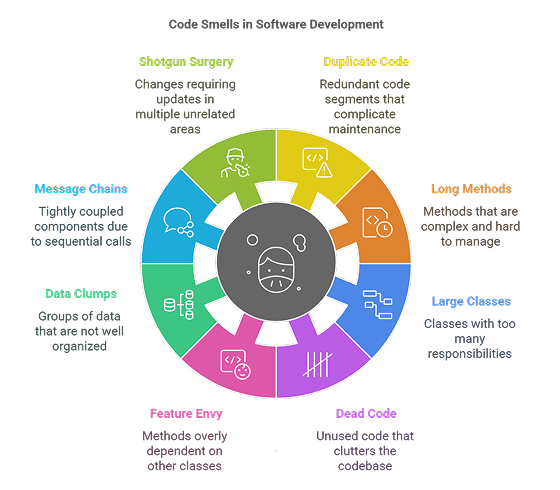Every developer has felt the subtle discomfort of reviewing code that seems “off.” Even though the code works without any visible issues, there is an underlying gut feeling that something is wrong. These subtle hints are known as “code smells.”
This article will guide you through recognizing common code smells, using detection tools, and following best practices to prevent them, ensuring your project’s health and efficiency.
What Are Code Smells?
Code smells, a term popularized by Martin Fowler and Kent Beck, refer to surface-level indicators in the code that suggest deeper design or structural issues. While they do not cause immediate errors, they can lead to technical debt and maintenance challenges as the codebase expands.
Common Types of Code Smells
Understanding and addressing standard code smells can significantly enhance your code’s longevity and usability. Here’s how you can identify and rectify several code smell types:

1. Duplicate Code
If you have duplicate code, any change to one instance requires you to remember to update the other. In a large codebase, this can be a lot of work and is often prone to errors. Furthermore, duplicate code creates redundancy and makes maintenance a nightmare.
Instead, refactor by creating a reusable function that can be called wherever needed.def calculate_area(length, width):
return length * width
def calculate_rectangle_area(length, width):
return length * width2. Long Methods
Long methods are often complex to understand, test, and debug. They tend to mix different levels of abstraction and do more than one thing. Break them into smaller, more specific functions.
def process_order(order):
validate_order(order)
calculate_price(order)
apply_discount(order)
charge_customer(order)
update_inventory(order)3. Large Classes
When a single class takes on too many responsibilities, it can quickly become unmanageable. This violates the Single Responsibility Principle (SRP) and can lead to circular dependencies.
class UserManager:
def create_user(self): pass
def delete_user(self): pass
def update_user(self): pass
def send_email(self): pass
def log_activity(self): pass
// Refactored version
class UserManager:
def create_user(self): pass
def delete_user(self): pass
def update_user(self): pass
class NotificationService:
def send_email(self): pass
class ActivityLogger:
def log_activity(self): pass
4. Dead Code
Dead code includes obsolete or unused methods and variables. It unnecessarily increases complexity and negatively impacts readability.
def legacy_function():
pass # This function is no longer referenced anywhere.5. Feature Envy
Feature envy occurs when methods excessively rely on another class’s functionality, suggesting misplacement of responsibilities and poor encapsulation.
class Customer:
def calculate_discount(self, order):
return order.get_discount() # Ideally belongs to the Order class.6. Data Clumps
Data clumps happen when data groups always move together but aren’t organized into proper structures or classes, leading to ambiguous interfaces and poor readability.
def schedule_event(start_date, start_time, end_date, end_time):
pass7. Message Chains
Message chains involve multiple sequential method calls, resulting in tightly coupled components. It complicates debugging and increases dependency across classes.
user.get_profile().get_address().get_city()8. Shotgun Surgery
Shotgun surgery requires altering numerous unrelated areas in the codebase to achieve a single functional change. It highlights poor cohesion and scattered responsibilities.
# Modifying a user’s detail affects multiple unrelated modules.
update_user_profile(user)
update_user_order(user)
update_user_notifications(user)
// Refactored version
class UserService:
def update_user(self, user):
self.update_profile(user)
self.update_order(user)
self.update_notifications(user)Code Smells Tools
Several specialized tools assist developers in efficiently identifying code smells:
- SonarQube & SonarLint: Both of these tools offer static code inspection and work as code smells detectors to assist developers in identifying issues during development.
- CodeClimate: Offers automated code review for maintainability and integrates with GitHub.
- DeepSource: Runs continuous code reviews and provides actionable insights to improve code quality.
Preventing Code Smells
Prevention involves implementing practices that foster high-quality code:
- Regular refactoring: Continuous refactoring keeps the codebase clean and maintainable, reducing complexity and improving readability.
- Adherence to clean code principles: Use meaningful variable names, keep functions concise, and ensure that each class has a clear, singular purpose.
- Comprehensive code reviews: A systematic methodology of code assessment ensures early identification of code issues, which generates group accountability while supporting uniform code excellence requirements.
- Automated analysis integration: Teams using automated detection tools in continuous integration will receive immediate feedback about smells, which helps them prevent the deterioration of problems before they become severe.
Conclusion
Maintaining a healthy code requires a complete understanding of code smells alongside proper management strategies. Even though these minor issues may appear insignificant at first, they will eventually slow down productivity. You can keep a clean and efficient code environment by using detection tools, embracing best practices, and committing to regular code reviews. Start taking action today to cultivate better coding practices for tomorrow.
